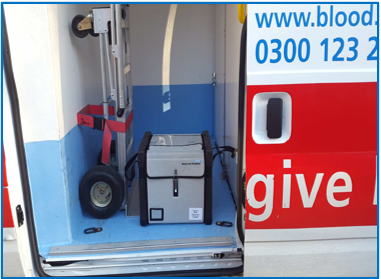Small journey transport box
For moving components within your hospital or transferring to other hospitals
Our small journey boxes (previously called short journey, with the name changed in February 2023) are for you to use to move components internally within your hospital (this does not include samples) and to transfer components to other hospitals.
Please print and insert the correct label (for red cells or platelets) into the label pocket (Word 15KB).
The labels provide key instructions when transporting the boxes internally within your hospital. Following these instructions will help ensure components arrive undamaged.
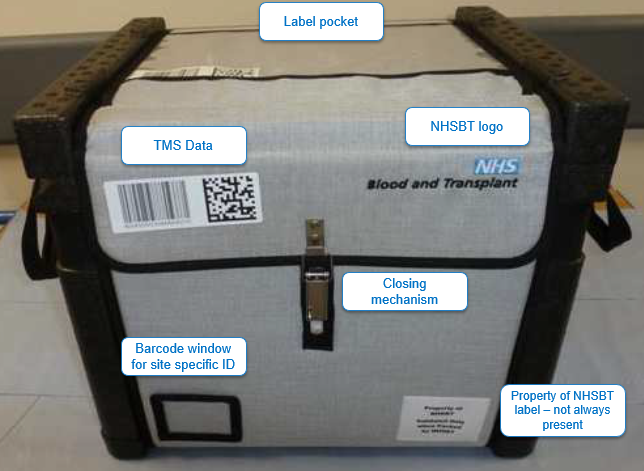
Phase Change Materials (PCMs)
Blue PCMs keep red blood cells at the correct temperature and are equilibrated for 72 hours. Blue PCM (PDF 528KB) safety data sheet.
Green PCMs keep platelets at the correct temperature and are equilibrated for 48 hours. Green PCM (PDF 583KB) safety data sheet.
Maximum number
Four is the maximum number to use; any more than this puts our staff at increased risk of injuries, and our drivers have the right to refuse to collect boxes with too many.
How to use PCMs
- When pre-conditioning, air gaps of at least 1.5 cm must be left between each PCM to ensure good air flow and equal preconditioning of each piece
- Using foam during storage helps keep components at the correct temperature and equilibration
- If space is restricted, cut the foam to fit neatly into temperature controlled areas or refrigerators
- Purchase (XLS 72KB) foam from the manufacturer
Returning PCMs to NHSBT
Whilst we have made PCMs available for hospital use, please avoid stockpiling them as this affects local availability. Please return PCMs with transport boxes at regular intervals. Damaged PCMs do not need to be returned and you may dispose them.

Transportation time limits and box capacity

If you require an accessible word version of this information email our customer service team NHSBTcustomer service@nhsbt.nhs.uk
Validation report
This report (PDF 48KB) details the tests performed to determine the time the containers will hold blood components at the standard storage temperature specification when packed in accordance with our datasheet DAT48 (PDF 199KB).
Boxes are validated between -5°C and +34°C ambient temperature.
How to pack a box for minimum and maximum loads
1 unit red blood cells. Ports folded. 1 stack x 1 unit
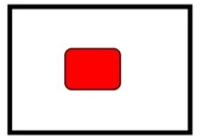
6 units red blood cells. Ports folded. 2 stacks x 3 units
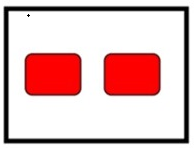
1 unit platelets. Laid flat. 1 stack x 1 unit
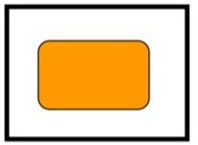
6 units platelets. Laid flat. 1 stack x 6 units

Check the box for damage before use
Light scratches or surface scuffs will not affect the integrity of the box but holes or broken lids etc. affect thermal performance which can have an adverse effect on components. Please note - boxes should not exposed to extremes of heat or cold while being stored.
Returning damaged boxes
Please label and return to your Hospital Services department for inspection and repair, or removal from the asset register if necessary.
Health and Safety
The following documents support Health and Safety initiatives.
- Example manual handling risk assessment (PDF 1297KB)
- If you need to perform a risk assessment refer to this example risk assessment (Word 118KB)
- Opening, closing and handling (PDF 328KB
- Instructions for maintenance and cleaning of short journey va-Q-tec transport containers and Phase Change Materials (PCM) (PDF 151KB)
User guide
Please protect yourself when handling a box by making sure you:
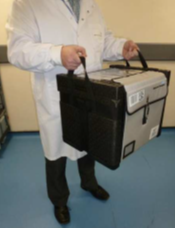
- Carry using both handles
- Hold upright
- Handle with care, when empty or full
- Use a trolley when handling more than one box
- Don't throw, and don't stack more than five high
How to prepare a box for transportation
Please take these steps to ensure safe transit:
- Fasten the box with a cable tie - a damaged tie, or no tie, may be a sign of tampering
- Stack several boxes securely
- Cover with a waterproof cover or container in a pannier or box on the back of a motorcycle
- Use a seatbelt if on a car seat
- If in a car boot make sure the box is fixed and unlikely to move
